Research on Sustainable Land Use Based on Production–Living–Ecological Function: A Case Study of Hubei Province, China
Abstract
1. Introduction
2. Materials and Methods
2.1. Study Area and Data Source
2.1.1. Study Area
2.1.2. Data Sources and Data Pre-Processing
2.2. Construction of Three-Dimensional Indicator System
2.3. Determine the Indicators’ Weight
- (1)
- Calculate the contribution of the th object to the th indicator.
- (2)
- Calculate the entropy value of the th indicator.The entropy value represents the total contribution of all the evaluation objects to the th indicator.
- (3)
- Calculate the diversity coefficient of the th indicator.The diversity coefficient () indicates the inconsistency degree of each evaluation object’s contribution under the th indicator, and the greater the is, the more important the th indicator will be.
- (4)
- Determine the weight coefficient.where means the weight of the th indicator. Thus, the weights determined by entropy weight method can be obtained as , satisfies the condition ≤ 1, .
2.4. Calculation of Land Use Functions
2.5. The Improved Coupling Coordination Degree Model
- (1)
- Based on the concept of coupling mechanism, in order to ensure the coupling among , and , only need to ensure that the coefficient of variation () is minimum.
- (2)
- Formula deformation:
- (3)
- In order to minimize , should be maximized.In general, , .
- (4)
- To make sure build the function
2.6. Regional Center of Gravity Theory
2.7. Obstacle Identification
3. Results
3.1. The Spatial and Temporal Characteristics of LUFs during 1996–2016
3.1.1. The Overall Level of LUFs during 1996–2016
3.1.2. The Spatial Distribution of LUFs during 1996–2016
3.1.3. The Center of Gravity of LUFs during 1996–2016
3.2. The Characteristics of Coupling Coordination Degree during 1996–2016
3.3. Diagnosis of Obstacle Degree of LUFs
3.3.1. Analysis of Obstacle Degree of Primary Obstacle Factors
3.3.2. Analysis of Obstacle Degree of Secondary Obstacle Factors
4. Discussion
5. Conclusions
- PF, LF and CF continued to increase during the study period, and the increment during 2006–2016 was greater than 1996–2006 periods. EF increased steadily during 1996–2011, but suddenly declined during 2011–2016. The improvement of PF and LF in HP was at the expense of EF to some extent.
- The overall level of D increased slightly during 1996–2006 and significantly increased during 2006–2016. of D remained stable during 1996–2006, but declined rapidly during 2006–2016. The increase in the overall level and the decrease in the differences between regions reflect a good development trend. However, although D improved steadily, the absolute level in 2016 was still at a relatively low level, which means there was still a lot of room for improvement.
- For primary obstacle factors, PF was always dominant, LF showed a downward trend, EF decreased during 1996–2011 and increased to a higher level during 2011–2016. For secondary obstacle factors, Benefit index (A2), Comfort index (B2) and Green index (C1) constituted the primary obstacle factors of each dimension. In 2016, the obstacle degree from high to low was A2, A1, A3, B2, C1, B1, B3, C3 and C2. For tertiary obstacle factors, obstacle factors that represent PF showed the characteristics of “the number decreased, the degree increased and occupying the top spot”. LF showed the characteristics of “the number and degree being stable and the ranking backward”. EF showed the characteristics of “the number and degree increased and the ranking forward”. Further, some of the main obstacle factors had more and more restriction on sustainable land use. Added-value of high and new technology industry (A2-3) and land use intensity (A3-2) were key factors restricting PF. Number of medical practitioner (B1-4) and internet penetration rate (B2-3) were key factors restricting LF. Air quality rate (C3-1) and wetland coverage rate (C1-4) were key factors restricting EF.
5.1. Implement a Strict System of Land Use Regulation to Achieve Orderly Land Use
5.2. Implement Industrial Layout Optimization Combined with Its Own Characteristics to Promote High-Quality and Sustainable Development of Land Use
5.3. Explore Underground Space Development to Open up a New Area of Land Use
5.4. Unified Protection and Restoration of Mountains, Rivers, Forests, Fields, Lakes and Grasses to Solve Ecological Problems Should Be Adopted
Author Contributions
Funding
Data Availability Statement
Acknowledgments
Conflicts of Interest
References
- Paracchini, M.L.; Pacini, C.; Jones, M.L.M.; Pérez-Soba, M. An aggregation framework to link indicators associated with multifunctional land use to the stakeholder evaluation of policy options. Ecol. Indic. 2011, 11, 71–80. [Google Scholar] [CrossRef]
- Verstegen, J.A.; Karssenberg, D.; van der Hilst, F.; Faaij, A.P.C. Detecting systemic change in a land use system by Bayesian data assimilation. Environ. Model. Softw. 2016, 75, 424–438. [Google Scholar] [CrossRef]
- Bach, P.M.; Staalesen, S.; McCarthy, D.T.; Deletic, A. Revisiting land use classification and spatial aggregation for modelling integrated urban water systems. Landsc. Urban Plan. 2015, 143, 43–55. [Google Scholar] [CrossRef]
- Pérez-Soba, M.; Petit, S.; Jones, L.; Bertrand, N.; Briquel, V.; Omodei-Zorini, L.; Contini, C.; Helming, K.; Farrington, J.H.; Mossello, M.T.; et al. Land Use Functions—A Multifunctionality Approach to Assess the Impact of Land Use Changes on Land Use Sustainability; Springer: Berlin/Heidelberg, Germany, 2008; ISBN 9783540786474. [Google Scholar]
- Liu, J.; Liu, Y.; Li, Y. Classification evaluation and spatial-temporal analysis of “production-living-ecological” spaces in China. ACTA Geogr. Sin. 2017, 72, 1290–1304. [Google Scholar]
- Zhang, H.; Erqi, X.; Zhu, H. An ecological-living-industrial land classification system and its spatial distribution in China. Resour. Sci. 2015, 37, 1332–1338. [Google Scholar]
- Jiaxing, C.; Jiang, G.; Jianwei, S.; Jing, L. The Spatial Pattern and Evolution Characteristics of the Production, Living and Ecological Space in Hubei Provence. China L. Sci. 2018, 32, 67–73. [Google Scholar]
- Yang, J.; Li, Y.; Hay, I.; Huang, X. Decoding national new area development in China: Toward new land development and politics. Cities 2019, 87, 114–120. [Google Scholar] [CrossRef]
- Nelson, E.; Mendoza, G.; Regetz, J.; Polasky, S.; Tallis, H.; Cameron, D.R.; Chan, K.M.A.; Daily, G.C.; Goldstein, J.; Kareiva, P.M.; et al. Modeling multiple ecosystem services, biodiversity conservation, commodity production, and tradeoffs at landscape scales. Front. Ecol. Environ. 2009, 7, 4–11. [Google Scholar] [CrossRef]
- Jin, G.; Chen, K.; Wang, P.; Guo, B.; Dong, Y.; Yang, J. Trade-offs in land-use competition and sustainable land development in the North China Plain. Technol. Forecast. Soc. Chang. 2019, 141, 36–46. [Google Scholar] [CrossRef]
- Peng, J.; Ma, J.; Du, Y.; Zhang, L.; Hu, X. Ecological suitability evaluation for mountainous area development based on conceptual model of landscape structure, function, and dynamics. Ecol. Indic. 2016, 61, 500–511. [Google Scholar] [CrossRef]
- Knickel, K.; Renting, H.; van der Ploeg, J. Multifunctionality in European agriculture. In Sustaining Agriculture and the Rural Economy; Brouwer, F., Ed.; Edward Elgar Publishing Inc.: Cheltenham, UK, 2004; pp. 81–103. [Google Scholar]
- Steinhäußer, R.; Siebert, R.; Steinführer, A.; Hellmich, M. National and regional land-use conflicts in Germany from the perspective of stakeholders. Land Use Policy 2015, 49, 183–194. [Google Scholar] [CrossRef]
- Marshall, E.J.P.; Moonen, A.C. Field margins in northern Europe: Their functions and interactions with agriculture. Agric. Ecosyst. Environ. 2002, 89, 5–21. [Google Scholar] [CrossRef]
- Gómez Sal, A.; González García, A. A comprehensive assessment of multifunctional agricultural land-use systems in Spain using a multi-dimensional evaluative model. Agric. Ecosyst. Environ. 2007, 120, 82–91. [Google Scholar] [CrossRef]
- Wiggering, H.; Dalchow, C.; Glemnitz, M.; Helming, K.; Müller, K.; Schultz, A.; Stachow, U.; Zander, P. Indicators for multifunctional land use—Linking socio-economic requirements with landscape potentials. Ecol. Indic. 2006, 6, 238–249. [Google Scholar] [CrossRef]
- Purushothaman, S.; Patil, S.; Francis, I.; König, H.J.; Reidsma, P.; Hegde, S. Participatory impact assessment of agricultural practices using the land use functions framework: Case study from India. Int. J. Biodivers. Sci. Ecosyst. Serv. Manag. 2013, 9, 2–12. [Google Scholar] [CrossRef]
- Kates, R.W.; Clark, W.C.; Corell, R.; Hall, J.M.; Jaeger, C.C.; Lowe, I.; McCarthy, J.J.; Schellnhuber, H.J.; Bolin, B.; Dickson, N.M.; et al. Environment and development: Sustainability science. Science 2001, 292, 641–642. [Google Scholar] [CrossRef]
- Zhou, D.; Xu, J.; Lin, Z. Conflict or coordination? Assessing land use multi-functionalization using production-living-ecology analysis. Sci. Total Environ. 2017, 577, 136–147. [Google Scholar] [CrossRef]
- Nguyen, T.T.; Verdoodt, A.; Van Y, T.; Delbecque, N.; Tran, T.C.; Van Ranst, E. Design of a GIS and multi-criteria based land evaluation procedure for sustainable land-use planning at the regional level. Agric. Ecosyst. Environ. 2015, 200, 1–11. [Google Scholar] [CrossRef]
- Zhen, L.; Cao, S.; Wei, Y.; Xie, G.; Li, F.; Yang, L. Land use functions: Conceptual framework and application for China. Resour. Sci. 2009, 31, 544–551. [Google Scholar]
- Gaodi, X.; Lin, Z.; Caixia, Z.; Xiangzheng, D.; Koenig, H.J.; Tscherning, K.; Helming, K. Assessing the Multifunctionalities of Land Use in China. J. Resour. Ecol. 2010, 1, 311–318. [Google Scholar] [CrossRef]
- Reidsma, P.; König, H.; Feng, S.; Bezlepkina, I.; Nesheim, I.; Bonin, M.; Sghaier, M.; Purushothaman, S.; Sieber, S.; van Ittersum, M.K.; et al. Methods and tools for integrated assessment of land use policies on sustainable development in developing countries. Land Use Policy 2011, 28, 604–617. [Google Scholar] [CrossRef]
- Liu, C.; Xu, Y.; Sun, P.; Liu, J. Progress and prospects of multi-functionality of land use research. Prog. Geogr. 2016, 35, 1087–1099. [Google Scholar]
- Hou, X.; Liu, J.; Zhang, D. Regional sustainable development: The relationship between natural capital utilization and economic development. Sustain. Dev. 2019, 27, 183–195. [Google Scholar] [CrossRef]
- Fang, F.; Qiao, L.L.; Ni, B.J.; Cao, J.S.; Yu, H.Q. Quantitative evaluation on the characteristics of activated sludge granules and flocs using a fuzzy entropy-based approach. Sci. Rep. 2017, 7. [Google Scholar] [CrossRef] [PubMed]
- Zhang, Z.; Zhou, M.; Ou, G.; Tan, S.; Song, Y.; Zhang, L.; Nie, X. Land suitability evaluation and an interval stochastic fuzzy programming-based optimization model for land-use planning and environmental policy analysis. Int. J. Environ. Res. Public Health 2019, 16, 4124. [Google Scholar] [CrossRef]
- Liu, D.J.; Li, L. Application study of comprehensive forecasting model based on entropy weighting method on trend of PM2.5 concentration in Guangzhou, China. Int. J. Environ. Res. Public Health 2015, 12, 7085–7099. [Google Scholar] [CrossRef] [PubMed]
- Wang, R.; Cheng, J.; Zhu, Y.; Lu, P. Evaluation on the coupling coordination of resources and environment carrying capacity in Chinese mining economic zones. Resour. Policy 2017, 53, 20–25. [Google Scholar] [CrossRef]
- Cheng, X.; Long, R.; Chen, H.; Li, Q. Coupling coordination degree and spatial dynamic evolution of a regional green competitiveness system—A case study from China. Ecol. Indic. 2019, 104, 489–500. [Google Scholar] [CrossRef]
- Li, Y.; Wang, J.; Liu, Y.; Long, H. Spatial pattern and influencing factors of the coordination development of industrialization, informatization, urbanization and agricultural modernization in China: A prefecture level exploratory spatial data analysis. Acta Geogr. Sin. 2014, 69, 199–212. [Google Scholar] [CrossRef]
- Walker, F.A. Restriction of immigration. JAMA J. Am. Med. Assoc. 1891, XVII, 938. [Google Scholar] [CrossRef][Green Version]
- Aboufadel, E.; Austin, D. A new method for computing the mean center of population of the United States. Prof. Geogr. 2006, 58, 65–69. [Google Scholar] [CrossRef]
- Chen, Y.; Luo, J. Derivation of relations between urbanization level and velocity from logistic growth model. Geogr. Res. 2002, 25, 1063–1072. [Google Scholar] [CrossRef]
- Chen, Y.; Luo, J. Dynamic Evaluation of Land Use Functions Based on Grey Relation Projection Method and Diagnosis of Its Obstacle Indicators: A Case Study of Guangzhou City. Geogr. Res. 2006, 25, 1063–1072. [Google Scholar] [CrossRef]
- Wei, C.; Wang, Z.; Lan, X.; Zhang, H.; Fan, M. The spatial-temporal characteristics and dilemmas of sustainable urbanization in China: A new perspective based on the concept of five-in-one. Sustainability 2018, 10, 4733. [Google Scholar] [CrossRef]
- Liu, C.; Xu, Y.; Huang, A.; Liu, Y.; Wang, H.; Lu, L.; Sun, P.; Zheng, W. Spatial identification of land use multifunctionality at grid scale in farming-pastoral area: A case study of Zhangjiakou City, China. Habitat Int. 2018, 76, 48–61. [Google Scholar] [CrossRef]
- Wang, L.; Li, F.; Gong, Y.; Jiang, P.; Huang, Q.; Hong, W.; Chen, D. A quality assessment of national territory use at the city level: A planning review perspective. Sustainability 2016, 8, 145. [Google Scholar] [CrossRef]
- Xie, H. Towards Sustainable Land Use in China: A Collection of Empirical Studies. Sustainability 2017, 9, 2129. [Google Scholar] [CrossRef]
- Wei, Y.D.; Ye, X. Urbanization, urban land expansion and environmental change in China. Stoch. Environ. Res. Risk Assess. 2014, 28, 757–765. [Google Scholar] [CrossRef]
- Pretty, J.; Benton, T.G.; Bharucha, Z.P.; Dicks, L.V.; Flora, C.B.; Godfray, H.C.J.; Goulson, D.; Hartley, S.; Lampkin, N.; Morris, C.; et al. Global assessment of agricultural system redesign for sustainable intensification. Nat. Sustain. 2018, 1, 441–446. [Google Scholar] [CrossRef]
- He, C.; Han, Q.; de Vries, B.; Wang, X.; Guochao, Z. Evaluation of sustainable land management in urban area: A case study of Shanghai, China. Ecol. Indic. 2017, 80, 106–113. [Google Scholar] [CrossRef]
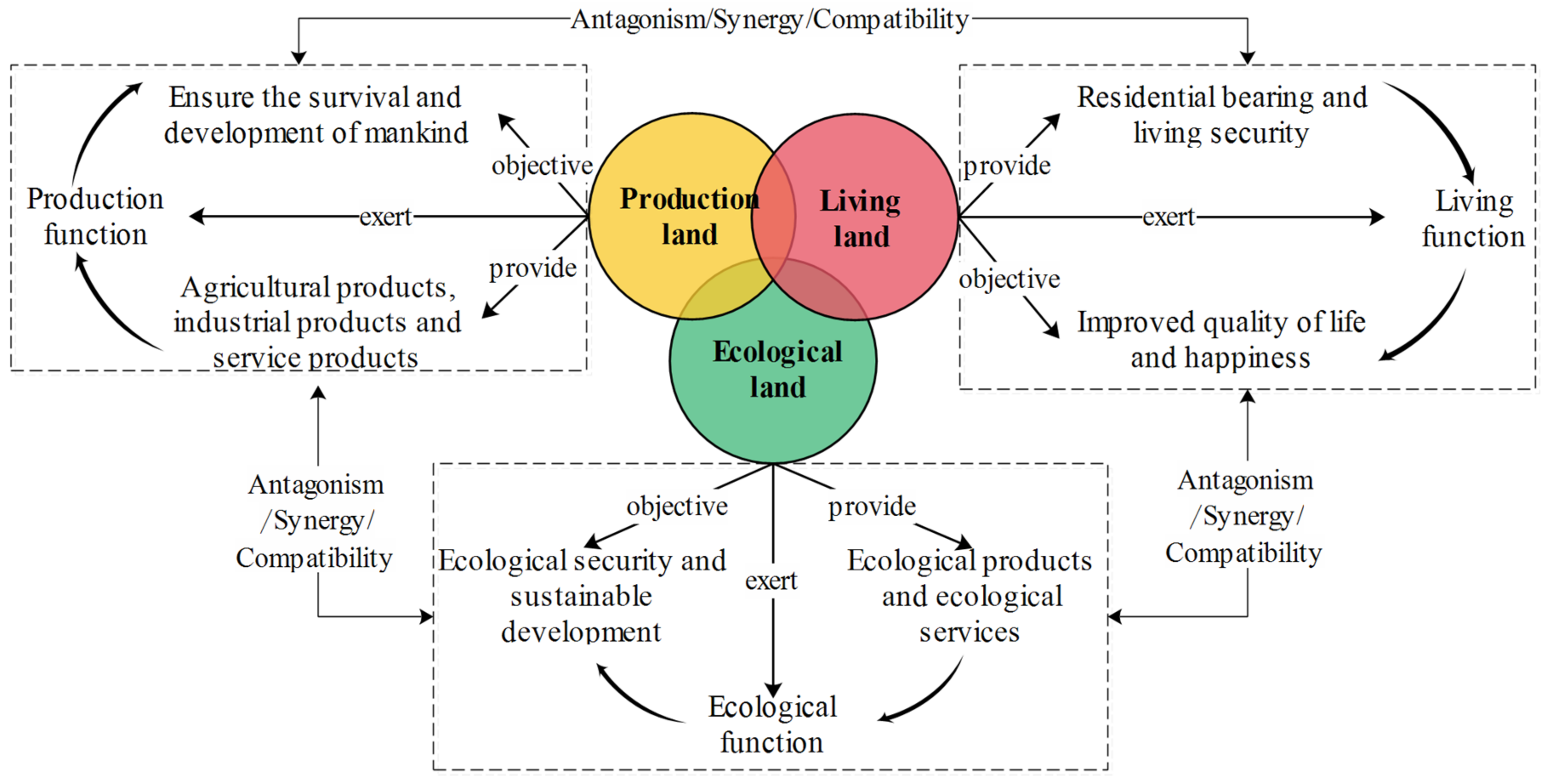

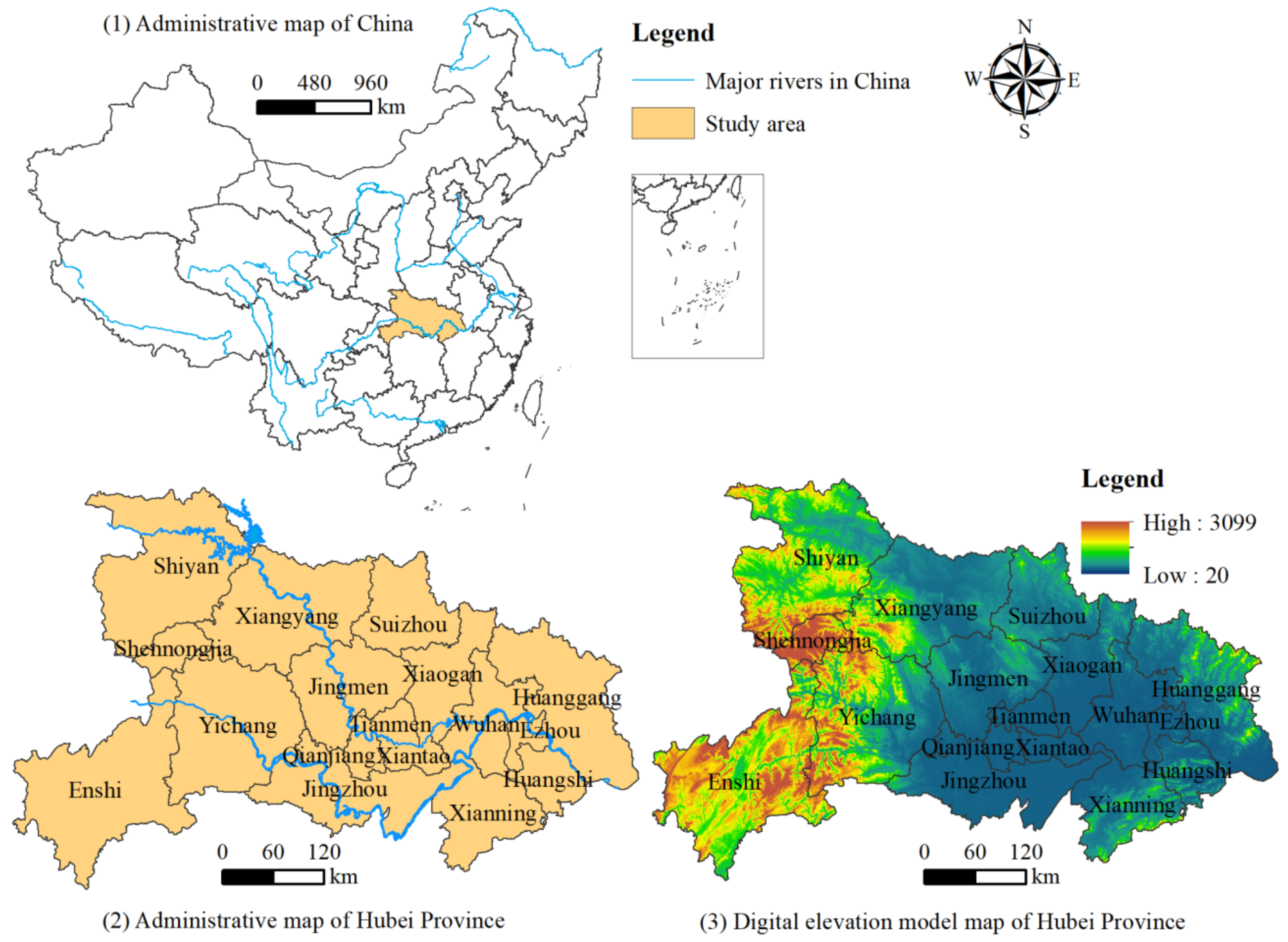
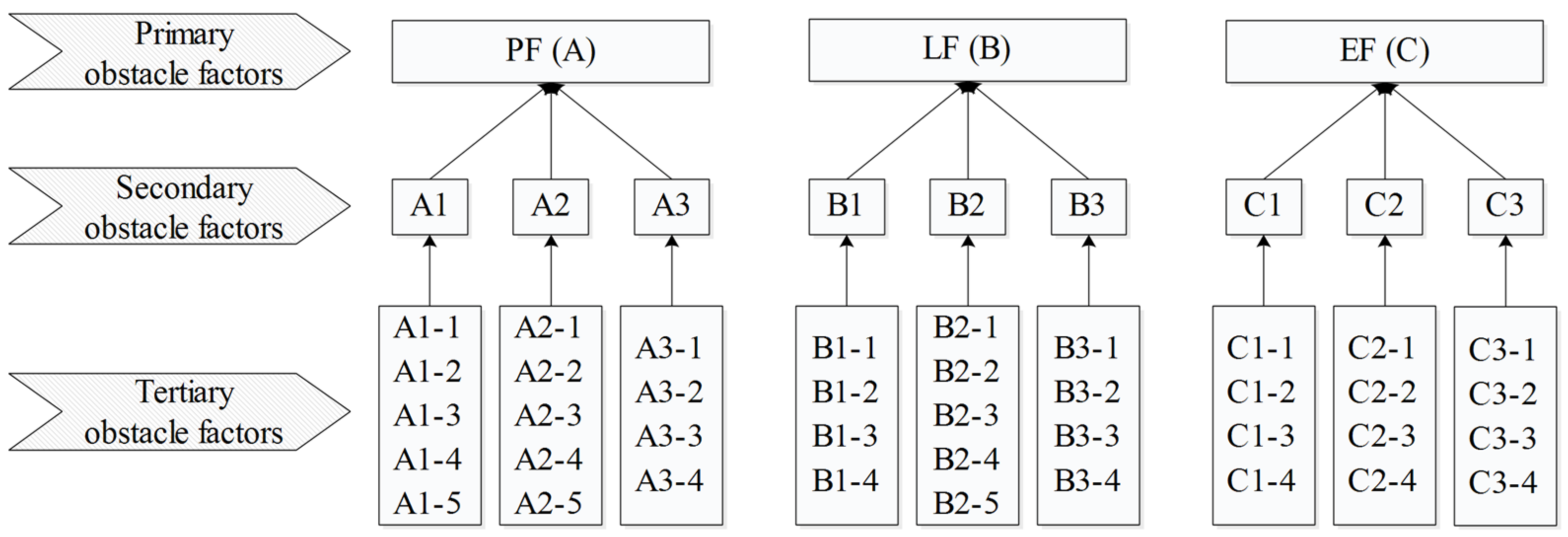
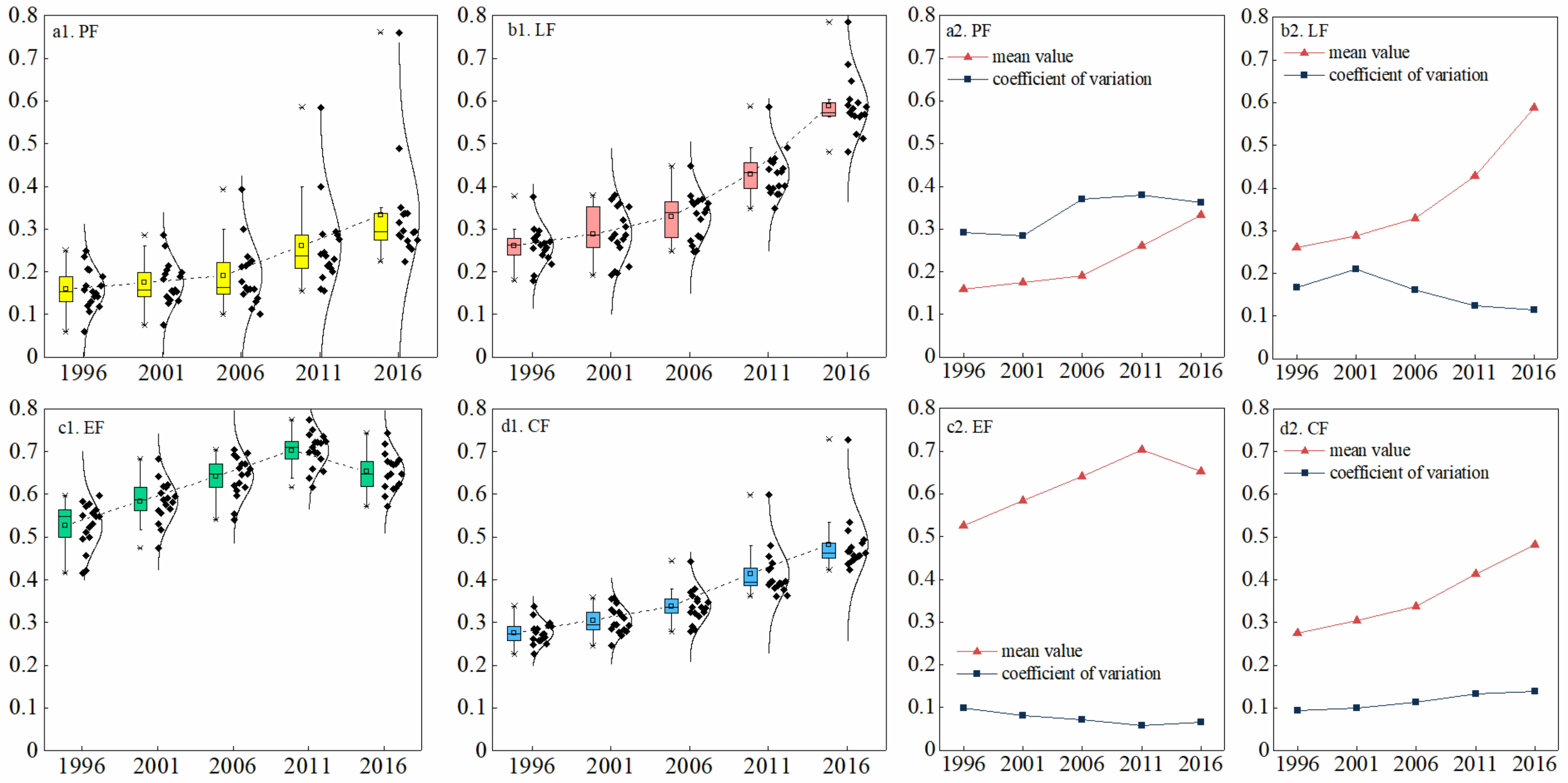
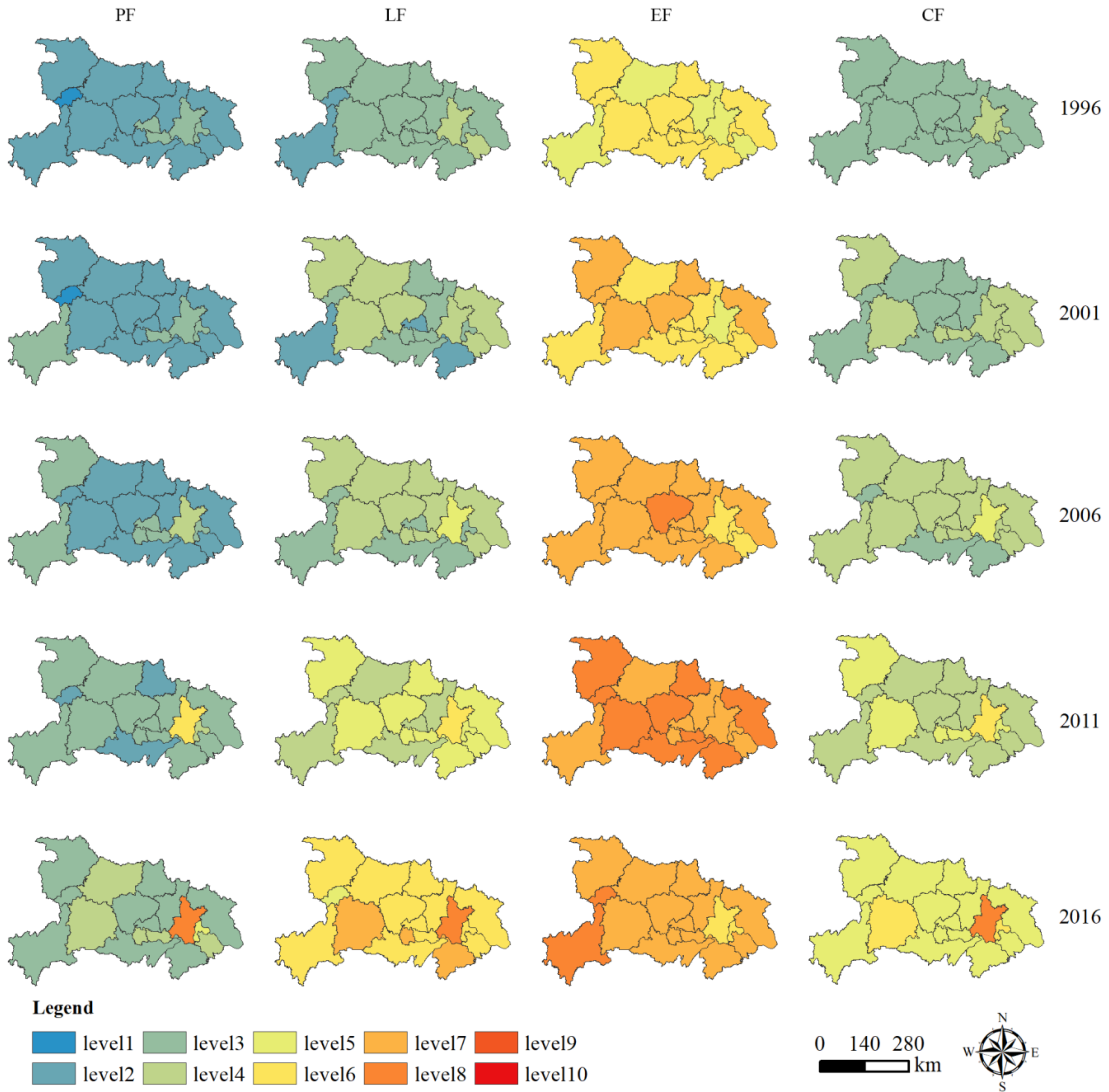
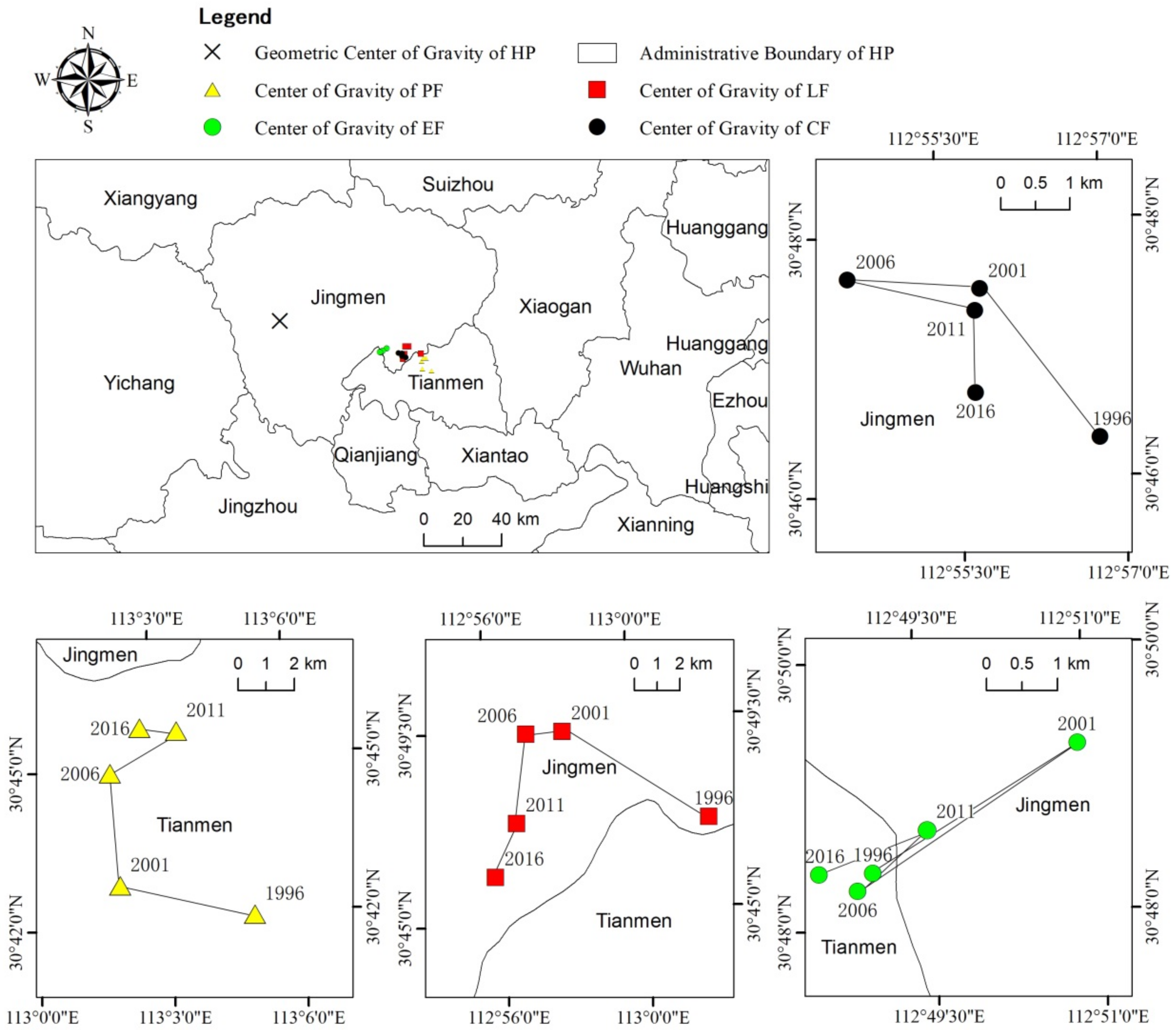
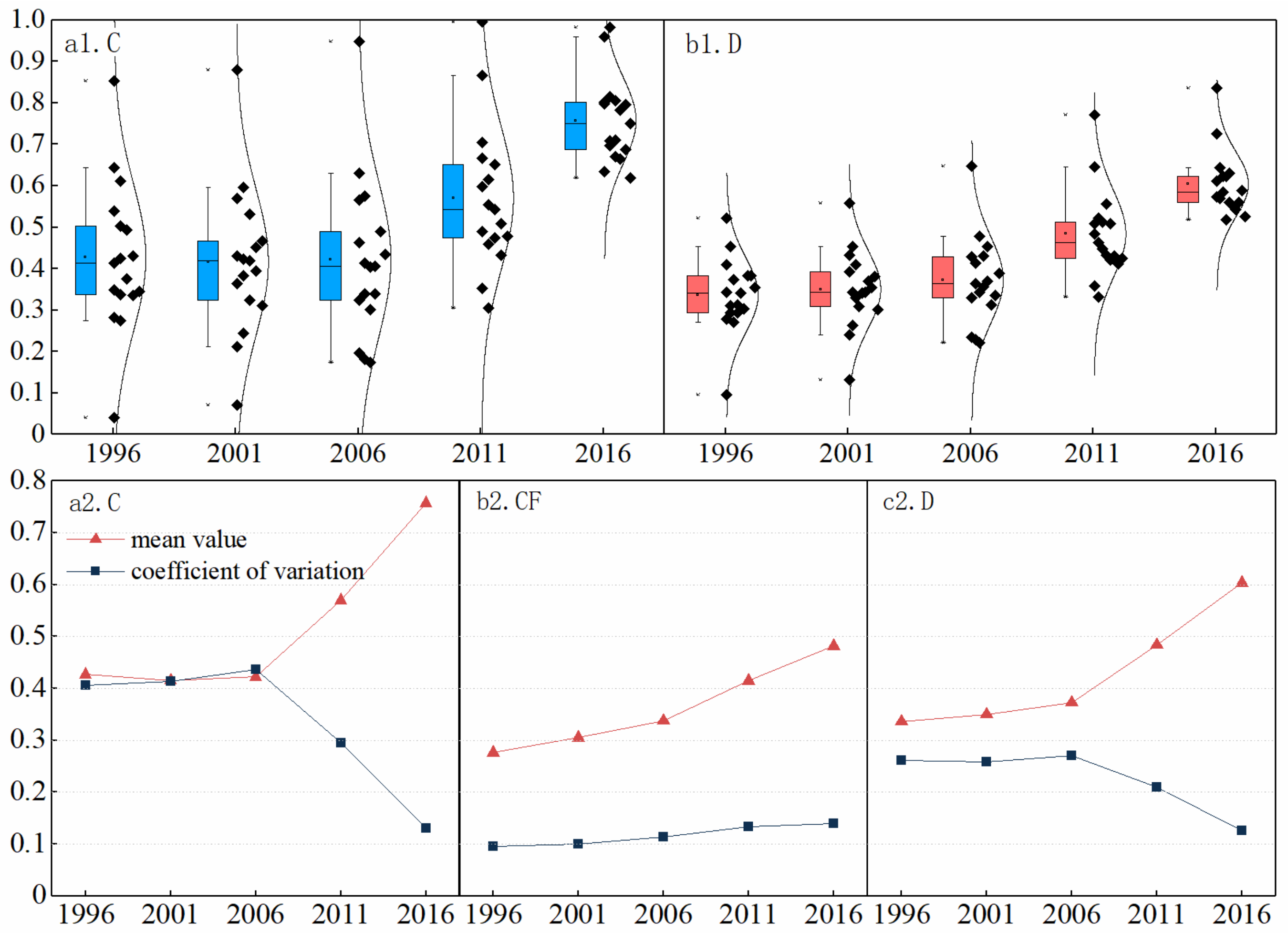
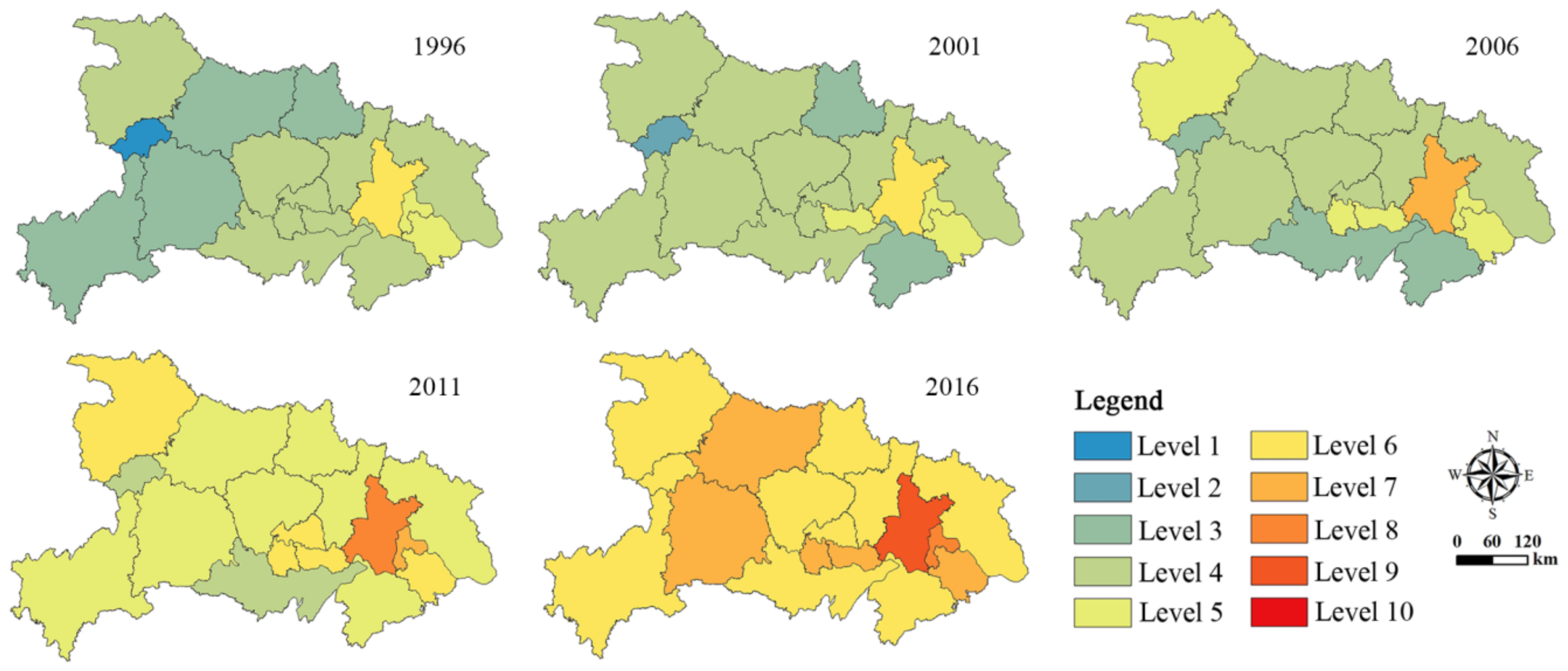
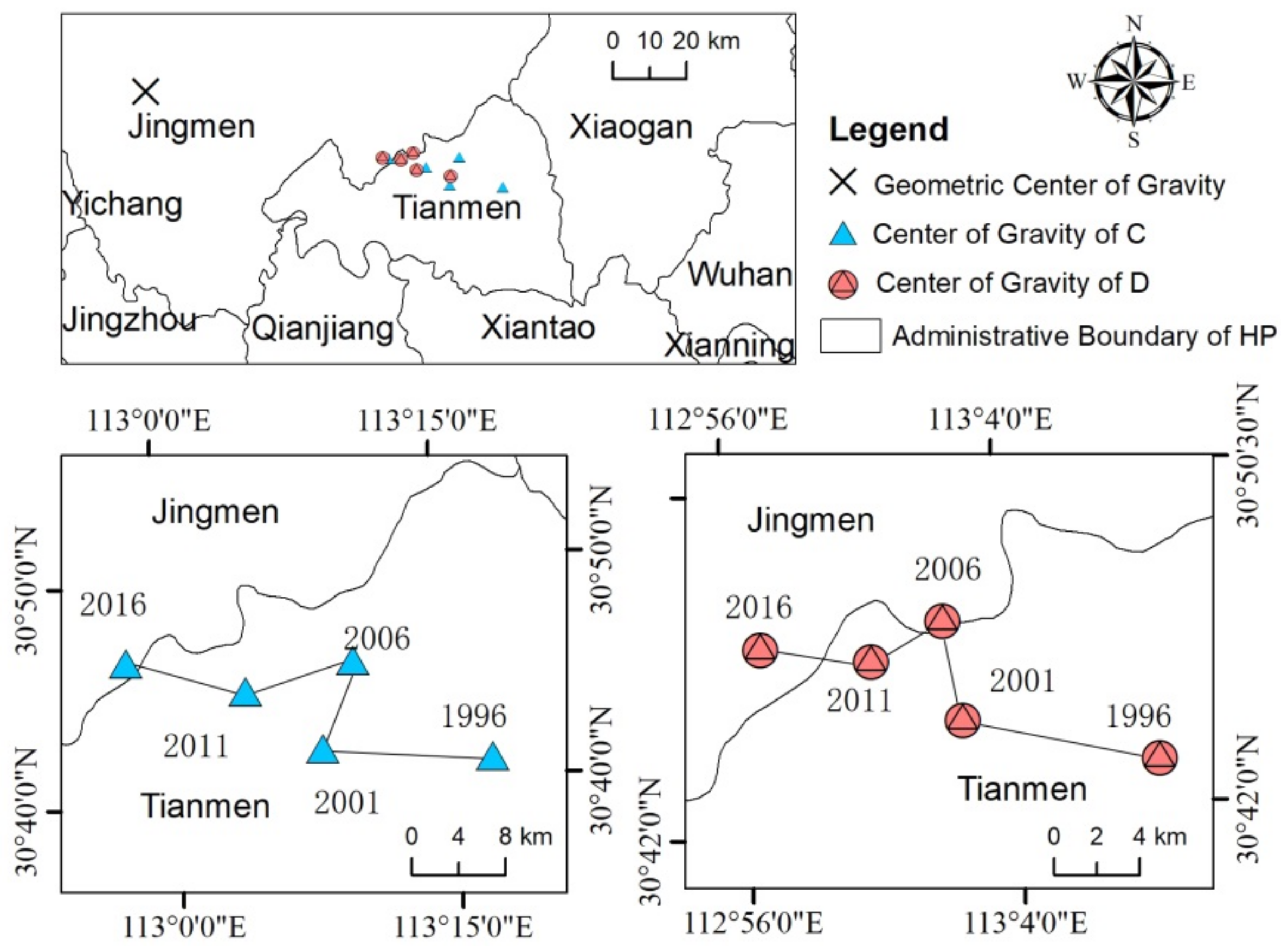

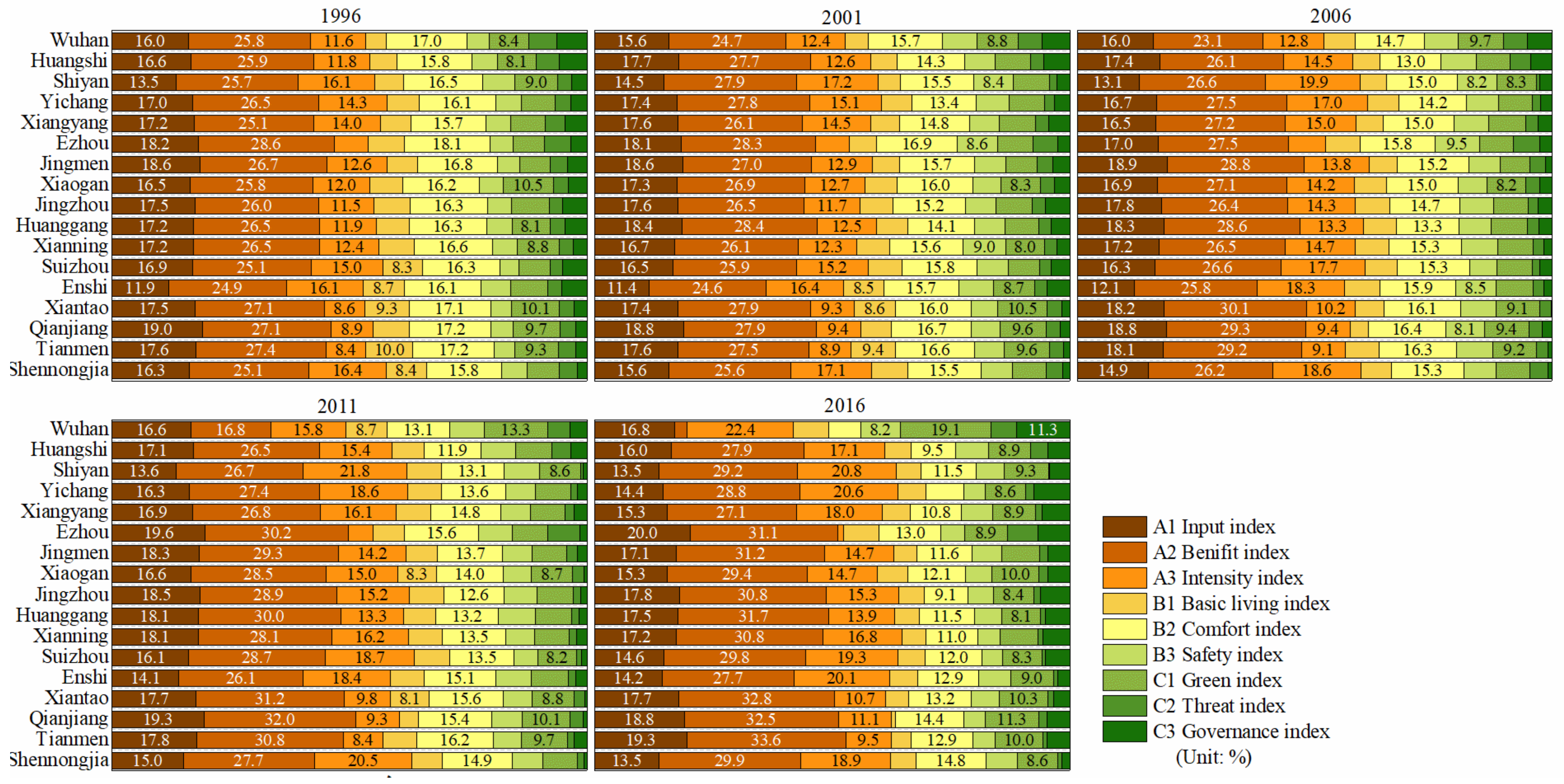
| Level 1 Indicators | Level 2 Indicators | Level 3 Indicators | Units | Weight |
|---|---|---|---|---|
| Production function A | Input index (A1) | A1-1 Investment of fixed assets per unit of construction land area (+) | 100 million RMB/km2 | 0.0413 |
| A1-2 Employment in secondary and tertiary industry per unit of construction land area (+) | person/km2 | 0.0419 | ||
| A1-3 Input intensity of R&D Expenditure (+) | % | 0.0355 | ||
| A1-4 Mechanical power of per unit of arable land area (+) | kW/hectare | 0.0108 | ||
| A1-5 Primary production laborers per unit of arable land area (+) | person/hectare | 0.0127 | ||
| Benefit index (A2) | A2-1 Fiscal revenue per unit of construction land area (+) | 10,000 RMB/km2 | 0.0419 | |
| A2-2 GDP of secondary and tertiary industry per unit of construction land area (+) | 100 million RMB/km2 | 0.0496 | ||
| A2-3 Added-value of high and new technology industry per unit of land area (+) | 100 million RMB/km2 | 0.0851 | ||
| A2-4 Added-value of primary industry per unit of arable land area (+) | 10,000 RMB/hectare | 0.0092 | ||
| A2-5 Yield per unit of sown area (+) | ton/hectare | 0.0123 | ||
| Intensity index (A3) | A3-1 Construction land area per capita (+) | m2 | 0.0378 | |
| A3-2 Development intensity of land space (+) | % | 0.0533 | ||
| A3-3 Multiple cropping index (+) | dimensionless | 0.019 | ||
| A3-4 Effective irrigation index (+) | dimensionless | 0.0253 | ||
| Living function B | Basic living index (B1) | B1-1 Drinking water penetration rate (+) | % | 0.0103 |
| B1-2 Fuel gas penetration rate (+) | % | 0.0061 | ||
| B1-3 Engel’s coefficient of urban family (−) | dimensionless | 0.0192 | ||
| B1-4 Number of medical practitioner per 10,000 people (+) | person | 0.0399 | ||
| Comfort index (B2) | B2-1 Urban housing area per capita (+) | m2 | 0.0188 | |
| B2-2 Disposable income of households per capita (+) | RMB | 0.0203 | ||
| B2-3 Internet penetration rate (+) | % | 0.046 | ||
| B2-4 Urban road area per capita (+) | m2 | 0.0136 | ||
| B2-5 Public transport per 10,000 people (+) | unit | 0.0248 | ||
| Safety index (B3) | B3-1 Registered unemployment rate in urban areas (−) | % | 0.0283 | |
| B3-2 Average rate of participation in basic pension insurance, basic medical care insurance and unemployment Insurance (+) | % | 0.0263 | ||
| B3-3 Number of criminal case per 10,000 people (−) | case | 0.0099 | ||
| B3-4 Ratio of urban income and rural income (+) | dimensionless | 0.0203 | ||
| Ecological function C | Green index (C1) | C1-1 Percentage of greenery coverage in built-up areas (+) | % | 0.0168 |
| C1-2 park land area per capita (+) | m2 | 0.0134 | ||
| C1-3 Forest coverage rate (+) | % | 0.0336 | ||
| C1-4 Wetland coverage rate (+) | % | 0.0377 | ||
| Threat index (C2) | C2-1 Energy consumption per unit GDP (−) | tce ※/10,000 RMB | 0.0307 | |
| C2-2 Discharge of industrial waste gas per unit of land area (−) | ton/km2 | 0.0167 | ||
| C2-3 Discharge of waste water per unit of land area (−) | ton/km2 | 0.0120 | ||
| C2-4 Discharge of solid waste per unit of land area (−) | ton/km2 | 0.0081 | ||
| Governance index (C3) | C3-1 Rate of good air quality (+) | % | 0.0335 | |
| C3-2 Industrial wastewater discharge compliance rate (+) | % | 0.0159 | ||
| C3-3 Rate of multipurpose use of solid waste (+) | % | 0.0088 | ||
| C3-4 Treatment rate of consumption wastes (+) | % | 0.0134 |
| Primary Obstacle Factors | 1996 | 2001 | 2006 | 2011 | 2016 |
|---|---|---|---|---|---|
| PF | 55.25 | 56.88 | 58.08 | 59.83 | 60.65 |
| LF | 28.98 | 29.22 | 28.81 | 27.72 | 22.58 |
| EF | 15.77 | 14.54 | 13.12 | 12.45 | 16.77 |
| Secondary Obstacle Factors | 1996 | 2001 | 2006 | 2011 | 2016 |
|---|---|---|---|---|---|
| A1 Input index | 16.75 | 16.86 | 16.71 | 17.05 | 16.41 |
| A2 Benefit index | 26.23 | 26.88 | 27.22 | 27.97 | 28.64 |
| A3 Intensity index | 12.27 | 12.78 | 14.14 | 14.81 | 15.60 |
| B1 Basic living index | 7.37 | 6.69 | 6.41 | 7.05 | 5.35 |
| B2 Comfort index | 16.53 | 15.50 | 15.08 | 14.10 | 11.48 |
| B3 Safety index | 5.09 | 6.85 | 7.32 | 6.57 | 5.74 |
| C1 Green index | 8.14 | 8.01 | 7.88 | 8.36 | 9.64 |
| C2 Threat index | 3.65 | 3.00 | 2.83 | 2.30 | 1.89 |
| C3 Governance index | 3.97 | 3.43 | 2.41 | 1.79 | 5.24 |
| 1996 | 2001 | 2006 | 2011 | 2016 | ||
|---|---|---|---|---|---|---|
| PF | Number | 123 | 127 | 124 | 119 | 108 |
| Proportion (%) | 72.35 | 74.71 | 72.94 | 70 | 63.53 | |
| Total degree (%) | 783.31 | 822 | 814.82 | 820.14 | 822.78 | |
| LF | Number | 33 | 32 | 35 | 37 | 34 |
| Proportion (%) | 19.41 | 18.82 | 20.59 | 21.76 | 20.00 | |
| Total degree (%) | 182.91 | 183.64 | 198.32 | 202.04 | 172.74 | |
| EF | Number | 14 | 11 | 11 | 14 | 28 |
| Proportion (%) | 8.24 | 6.47 | 6.47 | 8.24 | 16.47 | |
| Total degree (%) | 62.96 | 52.49 | 54.48 | 74.85 | 162.14 | |
| Top 10 obstacle factors | total | 1029.18 | 1058.13 | 1067.62 | 1097.03 | 1157.66 |
| Proportion (%) | 60.54 | 62.24 | 62.80 | 64.53 | 68.10 |
Publisher’s Note: MDPI stays neutral with regard to jurisdictional claims in published maps and institutional affiliations. |
© 2021 by the authors. Licensee MDPI, Basel, Switzerland. This article is an open access article distributed under the terms and conditions of the Creative Commons Attribution (CC BY) license (http://creativecommons.org/licenses/by/4.0/).
Share and Cite
Wei, C.; Lin, Q.; Yu, L.; Zhang, H.; Ye, S.; Zhang, D. Research on Sustainable Land Use Based on Production–Living–Ecological Function: A Case Study of Hubei Province, China. Sustainability 2021, 13, 996. https://doi.org/10.3390/su13020996
Wei C, Lin Q, Yu L, Zhang H, Ye S, Zhang D. Research on Sustainable Land Use Based on Production–Living–Ecological Function: A Case Study of Hubei Province, China. Sustainability. 2021; 13(2):996. https://doi.org/10.3390/su13020996
Chicago/Turabian StyleWei, Chao, Qiaowen Lin, Li Yu, Hongwei Zhang, Sheng Ye, and Di Zhang. 2021. "Research on Sustainable Land Use Based on Production–Living–Ecological Function: A Case Study of Hubei Province, China" Sustainability 13, no. 2: 996. https://doi.org/10.3390/su13020996
APA StyleWei, C., Lin, Q., Yu, L., Zhang, H., Ye, S., & Zhang, D. (2021). Research on Sustainable Land Use Based on Production–Living–Ecological Function: A Case Study of Hubei Province, China. Sustainability, 13(2), 996. https://doi.org/10.3390/su13020996






